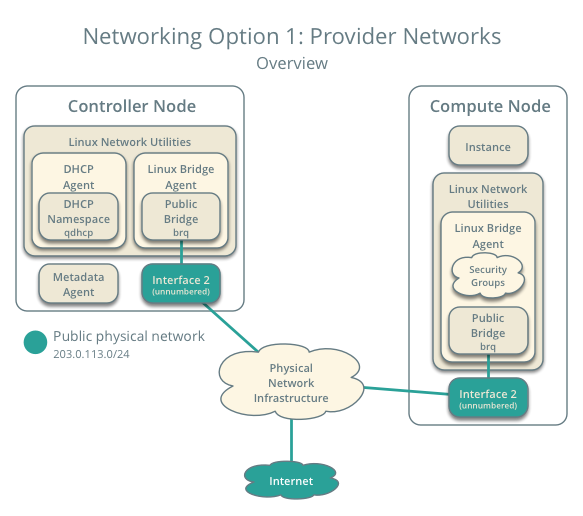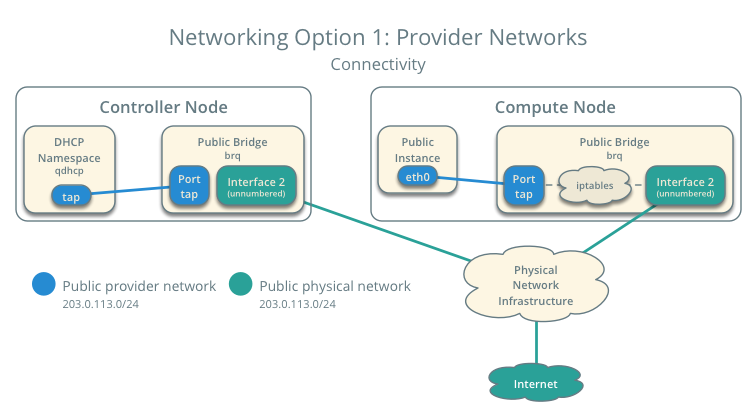Public provider network¶
Before launching an instance, you must create the necessary virtual network infrastructure. For networking option 1, an instance uses a public provider virtual network that connects to the physical network infrastructure via layer-2 (bridging/switching). This network includes a DHCP server that provides IP addresses to instances.
The admin or other privileged user must create this network because it connects directly to the physical network infrastructure.
Note
The following instructions and diagrams use example IP address ranges. You must adjust them for your particular environment.

Networking Option 1: Provider networks - Overview

Networking Option 1: Provider networks - Connectivity
Create the public network¶
On the controller node, source the admin credentials to gain access to admin-only CLI commands:
$ source admin-openrc.sh
Create the network:
$ neutron net-create public --shared --provider:physical_network public \ --provider:network_type flat Created a new network: +---------------------------+--------------------------------------+ | Field | Value | +---------------------------+--------------------------------------+ | admin_state_up | True | | id | 0e62efcd-8cee-46c7-b163-d8df05c3c5ad | | mtu | 0 | | name | public | | port_security_enabled | True | | provider:network_type | flat | | provider:physical_network | public | | provider:segmentation_id | | | router:external | False | | shared | True | | status | ACTIVE | | subnets | | | tenant_id | d84313397390425c8ed50b2f6e18d092 | +---------------------------+--------------------------------------+
The --shared option allows all projects to use the virtual network.
The --provider:physical_network public and --provider:network_type flat options connect the flat virtual network to the flat (native/untagged) public physical network on the eth1 interface on the host using information from the following files:
ml2_conf.ini:
[ml2_type_flat] flat_networks = public
linuxbridge_agent.ini:
[linux_bridge] physical_interface_mappings = public:eth1
Create a subnet on the network:
$ neutron subnet-create public PUBLIC_NETWORK_CIDR --name public \ --allocation-pool start=START_IP_ADDRESS,end=END_IP_ADDRESS\ --dns-nameserver DNS_RESOLVER --gateway PUBLIC_NETWORK_GATEWAY
Replace PUBLIC_NETWORK_CIDR with the subnet on the public physical network in CIDR notation.
Replace START_IP_ADDRESS and END_IP_ADDRESS with the first and last IP address of the range within the subnet that you want to allocate for instances. This range must not include any existing active IP addresses.
Replace DNS_RESOLVER with the IP address of a DNS resolver. In most cases, you can use one from the /etc/resolv.conf file on the host.
Replace PUBLIC_NETWORK_GATEWAY with the gateway IP address on the public physical network, typically the ”.1” IP address.
Example
The public network uses 203.0.113.0/24 with a gateway on 203.0.113.1. A DHCP server assigns each instance an IP address from 203.0.113.101 to 203.0.113.200. All instances use 8.8.4.4 as a DNS resolver.
$ neutron subnet-create public 203.0.113.0/24 --name public \ --allocation-pool start=203.0.113.101,end=203.0.113.200 \ --dns-nameserver 8.8.4.4 --gateway 203.0.113.1 Created a new subnet: +-------------------+----------------------------------------------------+ | Field | Value | +-------------------+----------------------------------------------------+ | allocation_pools | {"start": "203.0.113.101", "end": "203.0.113.200"} | | cidr | 203.0.113.0/24 | | dns_nameservers | 8.8.4.4 | | enable_dhcp | True | | gateway_ip | 203.0.113.1 | | host_routes | | | id | 5cc70da8-4ee7-4565-be53-b9c011fca011 | | ip_version | 4 | | ipv6_address_mode | | | ipv6_ra_mode | | | name | public | | network_id | 0e62efcd-8cee-46c7-b163-d8df05c3c5ad | | subnetpool_id | | | tenant_id | d84313397390425c8ed50b2f6e18d092 | +-------------------+----------------------------------------------------+
Return to Launch an instance - Create virtual networks.

Except where otherwise noted, this document is licensed under Creative Commons Attribution 3.0 License. See all OpenStack Legal Documents.